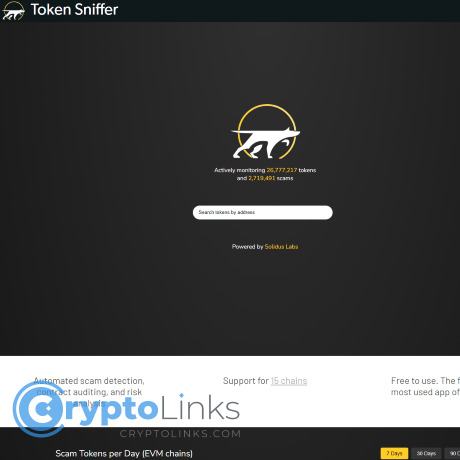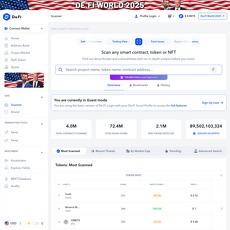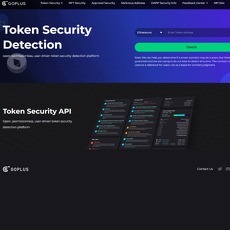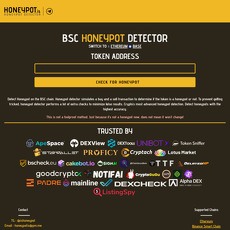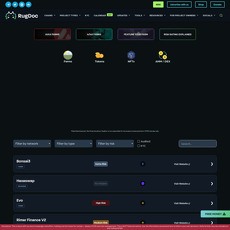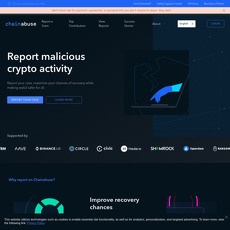Token Sniffer Review
Token Sniffer
tokensniffer.com
Token Sniffer (tokensniffer.com) Review Guide 2025: Everything You Need To Know + FAQ
Quick question: have you ever wished you could spot a honeypot or stealth rug in under a minute—before you become exit liquidity?
That’s exactly why I use Token Sniffer. It’s the fastest way I know to catch obvious red flags on new EVM tokens. I test tools like this and share what actually helps on my news blog here: cryptolinks.com/news. Read this and you’ll scan smarter, spot traps faster, and keep more of your money.
Describe problems or pain
Getting rugged hurts—and it’s usually preventable. Markets move at meme-speed, contracts are intentionally confusing, and Telegram “alpha” often turns into “oops.” Scanners help, but many people use them wrong. Here’s what goes wrong in the wild:
- Honeypot traps: You can buy but can’t sell, or selling is taxed at 90%+. I still see people “test buying” after a red honeypot flag. Don’t.
- Unlocked or fake-locked liquidity: LP sits in the dev wallet or is “locked” for a weekend with a sketchy locker, making a rug trivial.
- Sneaky owner powers: Minting, blacklisting, fee editing, pausing trading, or redirecting transfers through custom routers. One switch flipped, and you’re done.
- “Scores” misread: Traders ape because a scanner shows green, but ignore the details: who locked the LP, for how long, and can the owner change taxes later?
- Copy-paste contracts: A well-known scam contract gets slightly edited and reused. If you don’t check similarity, it looks “new” but behaves the same.
- Proxy and upgrade tricks: The contract you scanned today can be upgraded tomorrow to something totally different.
Industry reports from groups like Chainalysis and CertiK keep showing the same pattern: scams adapt fast, and “soft” rugs (like tax switches and stealth migrations) are still common. The painful part? Most of these could have been spotted early with a proper first-pass scan and a couple of quick manual checks.
“A scanner score isn’t a green light—it’s a warning light. Your job is to read what it’s warning you about.”
Here are a few real-world style scenarios I’ve run into:
- Looks safe, feels deadly: 5%/5% tax, verified contract… but the owner can raise fees to 100%. A calm chat says “we’ll renounce later.” If they can change taxes after you buy, they can trap you.
- LP “locked”—for 7 days: It passes a lock check, but the duration is a week and the locker is unknown. This sets up a “weekend rug,” not investor safety.
- Similarity red flag ignored: Contract looks fine until you notice it’s 90% similar to a known scam template with a blacklist function tucked away. Same trick, new ticker.
Promise solution
Here’s what you can expect from me in this guide: a no-BS process for using Token Sniffer the way I actually use it. I’ll break down the 0–100 score, the checks that matter most (honeypot, liquidity, mint, owner powers, similarity), what Token Sniffer misses, and the quick workflow I run through before I ever touch the buy button.
By the end, you’ll know exactly which warnings to trust immediately and which ones mean “slow down and verify.”
What you’ll get and who this is for
- Plain-English walkthrough: Read the score like a pro, not a gambler.
- Pro tips: The small details that get missed, like who locked LP and how long, or whether a “renounce” is real.
- Common mistakes to avoid: Green score complacency, ignoring similarity, trusting promises over on-chain facts.
- Quick checklist: A one-minute filter to cut obvious risks fast.
This is for you if:
- You trade on EVM chains (ETH, BSC, and friends) and see new tokens daily.
- You don’t want to read solidity for hours before a small buy.
- You’ve been burned before and want fewer surprises.
Not financial advice—just the exact process I follow to avoid the easiest traps.
So, what exactly does Token Sniffer check under the hood, and how do you read that score without getting fooled? Let’s unpack that next—starting with what Token Sniffer is and how it works in under a minute.
What is Token Sniffer and how it works
Token Sniffer is a fast, automated scanner for EVM tokens that reads the on-chain facts and turns them into a simple risk snapshot. Paste a contract address and, in seconds, you’ll see a 0–100 score with pass/fail checks for honeypot behavior, liquidity status, buy/sell taxes, mint permissions, owner powers, top holders, verification, and similarity to known scam patterns. It’s the kind of tool that stops “FOMO clicks” in their tracks.
“In a market where seconds cost money, visibility is protection.”
Think of it like an emergency flashlight for new tokens: it won’t tell you everything, but it will show you the hazards right in front of you.
Key features you’ll actually use
- Instant 0–100 score: A quick risk barometer, built from multiple contract and market checks. I use it as a yes/no filter to decide if a token deserves more of my time.
- Honeypot simulation: Simulates buys/sells to spot “can’t sell” traps or predatory sell taxes. A real-world reminder: the infamous 2021 Squid Game (SQUID) token became unsellable; scanners flagged it early, and those who listened avoided disaster. If the simulation screams honeypot, I don’t “test buy.”
- Liquidity status: Checks if liquidity is locked, who locked it, and for how long. Unlocked LP ≠ instant rug, but it’s a top risk. I always click through to see the locker and lock duration on-chain.
- Owner/creator powers: Highlights if the owner can mint more tokens, change fees, pause trading, blacklist/whitelist, or pull other levers. Centralized control is a common rug lever.
- Buy/Sell tax math: Calculates current taxes so you can avoid fee traps. “Normal” varies by meta, but 0–10% each way is typical; anything beyond demands a reason.
- Top holders and distribution: Spots whale clusters, team wallets, and outsized control. A “dead” or burn address holding a large share isn’t inherently bad; a fresh wallet holding 30% often is.
- Verified source code status: Notes if the contract code is verified on the explorer. Unverified code is a black box—you’re trusting what you can’t read.
- Contract similarity alerts: Compares code against known-risk templates. Copy-paste scam patterns get recycled every cycle; similarity flags help you catch déjà vu rugs.
- One-click context: Links to the block explorer, token socials, and sometimes recent trading info so you can do a quick sanity check without hunting around.
Why I trust this flow: scams aren’t rare edge cases. Chainalysis reported that rug pulls made up roughly $2.8B of scam revenue in 2021 alone—about 37% of all crypto scam revenue that year. Tools that surface obvious risks in seconds aren’t optional anymore—they’re seatbelts.
Supported networks and scope
Token Sniffer focuses on major EVM chains—expect coverage for networks like Ethereum and BNB Chain, with other EVMs appearing as support expands. Always confirm the network in the site’s selector before you scan; the same ticker can exist on multiple chains.
- Best with standard ERC-20–style tokens: That’s its sweet spot.
- Edge cases: Upgradeable proxies, custom routers, or complex tokenomics can reduce accuracy or return “no score.” In those cases, I pull up the block explorer and a second scanner to compare notes.
If a project brags about “security” but uses opaque proxies and unverified code, I treat that mismatch as a warning sign, not a flex.
Free to use, with possible limits
No signup needed—just paste an address and scan. During heavy traffic, you might feel rate limits or slower loads. Even so, the core scan is usually available and that’s what matters for quick triage.
- No wallet connection: You don’t have to connect a wallet to use Token Sniffer. That’s good opsec. Only copy/paste contract addresses.
- Data freshness: For brand-new launches or rapid contract upgrades, results can lag. If something looks off, refresh, re-scan later, or cross-check on the explorer.
So when that clean 0–100 number pops up, what’s actually under the hood—and how much should you trust it? Let’s break down the score next and separate the green lights from the mirages.
The Token Sniffer Score (0–100) explained
Here’s the truth: the Token Sniffer score is a fast gut-check, not gospel. It’s an automated roll-up of multiple checks that tries to answer a simple question—how risky is this token right now? The number is useful, but the real alpha sits in the details behind it.
“In crypto, numbers comfort you; details protect you.”
When I see an 8/100, I don’t panic—I click into the red flags and see why. Same with a 90/100; I still open every section because clean-looking tokens have trapped more people than obvious rugs. Think of the score as your radar. Your job is to fly the plane.
What drives a low score
Low scores usually come from clear, fixable risks—or outright traps. These are the settings that typically crush a token’s grade:
- Unlocked or tiny liquidity: If LP isn’t locked or is laughably small relative to market cap, exit liquidity can vanish in one click. In 2023, Chainalysis flagged rug pulls as a leading scam category—almost all of them relied on removable liquidity.
- Honeypot behavior: You can buy but can’t sell, or sell “works” with a 99% tax. If Token Sniffer shows red here, that’s game over for me.
- High or editable taxes: Buy/sell tax over ~10% is already spicy. Editable tax functions allow teams to flip to “max tax” after you enter. I often see 0/0 at launch that quietly turns 10/20 later.
- Mint enabled: If the owner can mint new tokens, they can nuke your position with supply inflation. I’ve seen “fair launch” claims with a hidden mint switch more times than I care to count.
- Centralized control: Functions like blacklist, whitelist, setMaxTx, or custom anti-bot throttles that the owner can toggle at will. These can freeze sellers while insiders escape.
- Trading disabled or restricted: Some contracts start with trading off or gated to a whitelist. If you can’t clearly verify the plan and timing, I’m out.
- Similarity to known scams: Token Sniffer compares code to patterns seen in past rugs. If it looks like a duck and quacks like a duck—assume feathers.
Real-world example pattern I’ve seen: a BSC meme token with 0/0 tax at launch, trading “works,” but liquidity is unlocked and the contract owner can setFees. Hours later, tax flips to 25/25, LP is pulled, and retail is stuck holding the bag. That token often scores under 20 even before the flip—if you read the checks.
What supports a higher score
High scores don’t guarantee safety, but they usually reflect transparent, battle-tested setups:
- Locked liquidity: LP locked via a reputable locker (e.g., Unicrypt, Team Finance, PinkLock) for a meaningful duration. Always click through to the on-chain lock tx.
- Renounced or time-locked ownership: Either ownership is renounced, or sensitive functions are behind a timelock/multisig. This reduces unilateral “gotchas.”
- Reasonable taxes: Sub-5% each way is common for non-rebase tokens; 0/0 is fine if functions can’t later raise it without a timelock.
- Clean holder distribution: No single wallet (besides a dead wallet) holding 20%+ of supply, and CEX/LP wallets are identifiable.
- Verified source code: Verified code on the block explorer with matching compiler settings. Transparency boosts trust.
- Standard routers and libraries: Using well-known routers and OpenZeppelin libraries reduces weird custom traps.
As a rule of thumb, I expect tokens with locked LP, verified code, sane taxes, and no owner shenanigans to land in the 70–95 range. Anything above 90 still gets the same scrutiny from me—complacency is expensive.
Red, yellow, green: how to read the flags
The color coding is your visual cue, but don’t stop at the colors:
- Red = immediate caution: Honeypot, unlocked LP, mint enabled, or blacklist powers. If you see two or more reds, close the tab—it’s not worth the “maybe.”
- Yellow = investigate: Editable taxes, recent ownership changes, partial locks, or unverified code. Yellow is where smart money slows down and asks for receipts.
- Green = good sign, not an all-clear: Green flags are encouraging, but I still click the locker link, scan owner functions, and check top holders. Trust, then verify.
Quick emotional check I use: if a green field makes you feel “safe,” pause and click one layer deeper. That extra 30 seconds has saved me from “green” tokens with sneaky upgradeable proxies more than once.
“Passed” doesn’t mean safe
Plenty of tokens pass basic checks and still go south. Here are the common ways that happens even when the score looks fine:
- Proxy upgrades: Implementation can be swapped after your buy. If the proxy admin isn’t locked or transparent, the rules can change mid-flight.
- Stealth migrations: Teams move liquidity to a new token without a fair swap path for holders, or “v2” siphons value away.
- Coordinated team dumps: Even with clean code, insiders can nuke price if they hold large allocations unlocked. Score doesn’t read intentions.
- Time-based tax switches: Taxes start low and jump later. Some contracts mask this behind innocuous-sounding functions.
Security firms have been shouting this for years. CertiK’s incident reports and the REKT leaderboard are full of “looked fine” tokens that failed outside the scanner’s scope. Passing checks is great—but it’s not a promise.
If a score comforts you, dig into the modules. If a module scares you, listen.
Now, here’s the real edge: how do you turn this score into a fast, repeatable decision before you hit buy? Want the exact two-minute flow I use to go from contract to confidence—without getting lost in noise?
How I use Token Sniffer step-by-step
Speed matters. So does checking the right things in the right order. Here’s my two-minute workflow that’s saved me from more traps than I care to admit.
“Trust comes from verification, not vibe.”
Step 1: Get the correct contract address
90% of mistakes start here. Scammers rely on copycats and lazy clicks. I always:
- Pull the contract from an official source: the project’s website, a pinned tweet from the verified account, or an announcement in the real Telegram/Discord.
- Cross-check on the block explorer (Etherscan / BscScan): symbol, decimals, and the creation transaction. Make sure the deploying wallet matches the team’s stated wallet if they’ve shared it.
- Avoid contracts shared by random commenters or “helpful” DMs. If a project won’t post the contract publicly, I pass.
Quick sanity checks: is the source code verified? Do the socials link back to the same contract? Are there cloned tokens with the same name but different addresses? If yes, that’s a giant red flag.
Step 2: Run the scan and pick the right chain
I paste the address into Token Sniffer and confirm the network is correct (ETH vs. BSC vs. other EVM). If there are multiple results, I match the exact address and chain—look at the first and last 6 characters. Wrong chain = wrong data.
Tip: If the token uses a proxy, Token Sniffer might show the proxy address. I’ll also check the implementation contract on the explorer (Contract tab → “Read as Proxy” / “Implementation”).
Step 3: Read the essentials like a pro
I don’t stare at the score. I scan the checks in this order and decide fast:
- Honeypot test: If it says selling is blocked or taxed to absurd levels, I’m out. No “test buys.”
- Liquidity lock: Is LP locked? By whom and for how long? I want a real locker (Unicrypt, Team Finance, PinkLock) and a meaningful period (weeks to months, not hours). I click the locker link and view the on-chain lock transaction.
- Owner powers: Can the owner mint new tokens, blacklist/whitelist, pause trading, change taxes, or limit max transactions/wallets post-launch? Any two of these together is enough to skip.
- Taxes: Buy/sell tax should be reasonable and ideally not changeable by the owner. I get wary if total tax is above ~10% or if there’s a big sell tax discrepancy (e.g., 5% buy, 20% sell).
- Top holders: Are there whales? Is a “dead wallet” holding a large chunk (legit burns show up there)? If one wallet holds 20%+ with no lock, that’s risk. I also check if the LP token itself is unlocked in a deployer wallet.
- Contract similarity: If it’s flagged as similar to known scams or risky patterns, I stop and investigate. A “clean” similarity result is comforting, not conclusive.
Real-world snapshot: I once scanned a hyped BSC token that “passed” basic checks but showed an owner function to adjust maxTx after launch. Two days later, they cut the max sell to peanuts—holders couldn’t exit while the team dumped. The scanner didn’t scream rug, but the owner power was the tell.
Another time, a token looked fine except LP was “locked” for 24 hours on a no-name locker. At hour 25, liquidity vanished. Since then, I only count locks from reputable lockers and for real durations.
Step 4: If “Not found” or “No score”
New tokens, proxies, or quirky routers can confuse scanners. Here’s how I handle it:
- Re-scan after a few minutes. Early liquidity events can lag.
- Open the explorer’s Contract tab. If it’s a proxy, follow the Implementation and scan that address.
- Check Transfers/Holders: is liquidity actually added to a known DEX pair? Are holders real or a bot swarm?
- Cross-check with one more tool (GoPlus, De.Fi, RugDoc). If two scanners can’t read it and the team can’t explain why, I walk.
Step 5: Quick go/no-go checklist
When I’m moving fast, I use this short list. If it fails on any two points, I skip—there’s always another chart.
- No honeypot on the test.
- LP locked by a reputable locker for a meaningful period (weeks+). Link and verify the lock tx.
- Owner powers limited: no mint, no arbitrary blacklist/whitelist, no stealth tax edits, no sneaky maxTx traps.
- Taxes reasonable and stable (ideally under ~10% total, no surprise sell tax spikes).
- Healthy holder spread; whales controlled or locked; burns to a dead wallet are real.
- No scary similarity flags to known scams or malicious templates.
Why this discipline? Because scammers are prolific—industry analyses (for example, by Solidus Labs and others) have shown that bad actors have pushed out hundreds of thousands scam tokens across EVM chains in a single year. The patterns repeat; the “stories” just change.
If you’ve ever felt that pit in your stomach after buying a chart that never lets you sell, you know why these five steps matter. Want to know the traps Token Sniffer can’t always catch—and how I double-check them in under a minute? The next section has the blind spots most traders miss. Ready to see the ones that slip past scanners?
Limits, blind spots, and how to double-check safely
Scanners are amazing until they aren’t. Token Sniffer catches a lot in seconds, but the nastiest traps often live just outside its line of sight. Here’s exactly where I’ve seen people get clipped—and how I avoid it.
Common blind spots
- Upgradeable proxies — A token can look clean, then the team flips the implementation contract later. On Etherscan, look for a Proxy label, the “Read as Proxy” tab, and an Implementation address. If there’s an upgrade admin, they still control the code even if they “renounced” the token contract.
- Tax switch after launch — Sellers get crushed when the owner raises sellTax from 0% to 30%+ hours after you buy. Names to look for in code/ABI: setTax, setFees, updateFees, setBuyTax, setSellTax. If these exist with onlyOwner, assume they can be changed anytime.
- Hidden external limiters — Anti-whale and anti-bot toggles can secretly block sells or cap wallets:
- Functions like setMaxTxAmount, setMaxWallet, setCooldown
- Blacklist/whitelist gates: setBlacklist, excludeFromFee, setTradingEnabled
- Router/pair restrictions that only allow trading through a custom router
- Fake or short locks — LP “locked,” but only 1–5% is locked, the rest is free to pull. Or it’s locked for 1–7 days, which is basically a timed rug. Worse: devs “burn” to an address they control.
- Social engineering — Announcing “ownership renounced” while keeping a proxy admin, a separate operator role, or a multisig with god-mode. The headline looks safe; the power still exists.
“In crypto, the code is the truth—but only if you bother to read it.”
If you want receipts: year after year, security firms highlight exit scams and rug patterns as top loss drivers. CertiK’s quarterly roundups repeatedly show exit scams at or near the top, and Solidus Labs previously tracked hundreds of thousands of scammy tokens with manipulative code patterns in the wild. It’s not rare. It’s the business model.
Cross-check with other scanners
I never stop at one result. I want a second opinion and the raw chain data:
- De.Fi Scanner — Good for permission flags and contract risks.
- GoPlus Security — Clear readouts for blacklist/whitelist, mint, and trading control.
- RugDoc (strong on BSC) — Human notes and pattern warnings.
- StaySafu — Quick second scan to spot mismatches.
- Etherscan / BscScan — The source of truth for code, holders, and transactions.
If two scanners disagree, the explorer settles it. Always.
Manual checks that still matter
These take under two minutes and have saved me from avoidable hits:
- Verify the LP lock on-chain — Click the token’s pair, then the LP token, and check holders. Real locks often sit in known lockers like Unicrypt, Team Finance, or PinkLock. Confirm the lock transaction hash, the amount locked (majority of LP), and the unlock date is meaningful (months, not days).
- Look for proxies and admins — On the contract page, if you see “Proxy,” open the implementation. If there’s an admin address with power to upgrade, any “renounce” claim is cosmetic.
- Scan owner powers — In “Write Contract,” skim for dangerous functions:
- setFees, setTax, setMaxTxAmount, setMaxWallet, setBlacklist, setTradingEnabled
- Any mint or setBalance function
- Non-standard routers or transfer hooks: _beforeTokenTransfer, _transfer logic with conditionals
- Router sanity check — Standard routers:
- UniswapV2: 0x7a250d5630B4cF539739dF2C5dAcb4c659F2488D
- Pancake V2: 0x10ED43C718714eb63d5aA57B78B54704E256024E
If your token routes through a mystery address, ask why.
- Holder distribution and “dead” wallets — A healthy spread beats a whale with 25% of supply. If LP is “burned,” it should be 0x000000000000000000000000000000000000dEaD or 0x0000000000000000000000000000000000000000. Anything else is not a standard burn and could be controlled.
- Socials and history — Are the socials real, active, and consistent with the contract address? Does the creator address have past rugs or shady deployments? A 30-second scroll on the creator’s address can save a bankroll.
Real-world example I’ve seen repeatedly: a token launches with 0/0 tax and passes automated checks. Hype builds, volume spikes, then the team flips setSellTax to 30% and enables a subtle blacklist on certain holders. Technically not a “honeypot” at launch—practically the same outcome when you try to exit.
When to skip the trade
- Any honeypot or sell-block signal, even if “temporary for anti-bot.” No thanks.
- LP not locked, locked for days, or only a tiny fraction locked. If they won’t post the lock TX, I’m out.
- Extreme or editable taxes (e.g., >10% each side, or owner can raise at will).
- Blacklist/whitelist powers that can be turned on anytime.
- Proxy with upgrade admin and no transparency plan. If they control the switch, they control your risk.
- Creator with a dirty history. Patterns repeat. Don’t be the next test case.
Quick gut-check I use: if I need a long explanation from the team to justify a permission, I pass. Clean setups don’t need essays.
Want straight answers to the questions I get all the time—how reliable the score is, how the honeypot test actually works, and what to do when a legit token still flags? I’m covering those next in the FAQs, and I’ll keep it brutally practical. Ready?
Token Sniffer FAQs (real questions people ask)
Quick, no-nonsense answers to the questions I get all the time. I’ll keep it practical and share a few real examples from my own scans.
Is Token Sniffer reliable?
Reliable for fast risk detection, not for guarantees. I use it as a first filter to catch obvious traps, then I confirm on a block explorer and one more scanner.
- What it’s great at: Flagging honeypots, unlocked/low liquidity, mint/blacklist powers, and abnormal taxes.
- Where it can wobble: Upgradeable proxy contracts, exotic routers, and tokens that change parameters after launch.
Real sample: I scanned a fresh BSC meme coin that looked fine at first glance on socials. Token Sniffer showed “owner can set fees” and “liquidity not locked.” I skipped. A few hours later, seller tax was toggled to 45% and early buyers got drained on exit. That’s exactly the kind of thing a quick scan helps you avoid.
Context: Public industry reports (e.g., Chainalysis and CertiK yearly crime overviews) consistently show scams like rugs/honeypots are a major loss category. Tools like Token Sniffer reduce exposure to the most common patterns, but nothing replaces reading on-chain permissions yourself.
How does the honeypot test work?
It simulates buy/sell behavior against the token’s contract and router to see if selling is blocked or effectively impossible due to extreme taxes or blacklisting.
- Common honeypot tricks: Blacklist/whitelist functions, max-tx or max-wallet limits that “unlock” for insiders only, sell taxes cranked to 100% mid-trade, or reverts on sells.
- What to do if it flags honeypot: Don’t “test buy.” Just leave it. Honeypots often include conditional logic to let certain wallets sell and trap others.
Real sample: One token passed buys but failed sells for non-whitelisted wallets. Token Sniffer flagged it red. A few hours later, the team “opened” sells for a short window, then closed them again for everyone except their own wallets. If the honeypot check screams, I listen.
Why does a legit token score low?
New launches often start with conservative or centralized settings that hurt the score:
- High taxes at launch to deter snipers; later reduced.
- Ownership not renounced yet because they plan to tweak limits/liquidity first.
- Liquidity temporarily unlocked while they consolidate pools.
- Unverified source code in the first hours.
What I do: I screenshot the scan, wait for the promised changes, then re-scan and confirm those changes on the block explorer. I don’t trade on promises or countdowns—only on-chain facts.
Is Token Sniffer safe to use?
Yes. It’s view-only scanning. You don’t need to connect your wallet to read a score.
- Always type the URL directly: tokensniffer.com.
- Never sign messages or “connect” just to scan a token.
- Copy/paste the contract address—don’t click random links from chats.
Tip: Scammers clone scanner UIs. If a “scanner” asks you to approve anything, close the tab.
Which chains are supported?
Major EVM chains are covered (Ethereum, BNB Chain, and others). Coverage shifts over time, so always check the network selector on the site before you scan.
Quick sanity check: If a token is on BNB Chain but you scanned on Ethereum, you’ll get weird or empty results. Match the chain, then the contract.
What are good Token Sniffer alternatives?
I always cross-check with one more tool plus the chain’s explorer:
- De.Fi Scanner — solid risk breakdown and permission checks.
- GoPlus Security — quick token security API; many wallets integrate it.
- RugDoc — especially useful on BSC and for yield/project reviews.
- StaySafu — simple, fast checks; nice complement.
- Etherscan / BscScan — verify contract, holders, locker txs, and comments.
Two scanners that agree plus a clean on-chain read usually keep me out of trouble.
Can I use it on mobile?
Yes, it works fine on mobile browsers.
- Double-check every pasted contract address; mobile autocorrect can mangle strings.
- Open project links from official sources only (pinned tweet, verified site).
- For safety, view the contract on the explorer first and tap the Token Sniffer link from there if available.
One last thing: want my 60-second pre-buy checklist and a dead-simple “skip or go” rule that saved me from more rugs than I can count? That’s up next—stick with me.
Final thoughts and your game plan
Here’s the truth: if you spend one minute doing the right checks, you’ll avoid most of the traps that catch people in the first hour of a launch. I’ve passed on countless “moonshots” because a quick scan showed unlocked LP, tax switches, or owner backdoors—and a day later those charts looked like cliff dives.
And it isn’t just gut feel. Independent analyses have shown how common scammy token patterns are. Solidus Labs reported that more than 200,000 malicious tokens were deployed across major EVM chains since 2020, with double-digit percentages of newly created tokens showing fraud-like traits at launch. Chainalysis has repeatedly highlighted that rug pulls and token scams remain a steady slice of on-chain scam revenue year after year—even as methods evolve. Translation: tools help, but habits save you.
60-second checklist before you buy
- Run a scan: Paste the exact contract and confirm the network. If the honeypot test is red, that’s the end of the story.
- Liquidity lock: Look for a real lock via a known locker (e.g., Unicrypt, Team Finance, PinkLock). Click through to the locker’s on-chain tx and confirm the LP tokens are there and the unlock date isn’t “tomorrow.”
- Owner powers: No mint, no blacklist/whitelist shenanigans, no sneaky fee or maxTx edits. If ownership isn’t renounced, I want a multisig and visible timelocks.
- Taxes: Keep it sane. If buy/sell taxes are sky-high or can be changed freely, that’s a trap door. I avoid anything that can flip to 99%.
- Holder spread: Top 10 shouldn’t own the entire supply (excluding the burn/dead wallet). Watch for “team” wallets hiding behind fresh addresses.
- Similarity flags: If it matches known scam patterns, I don’t argue with history.
- Cross-check: Open the block explorer. Is the code verified? Any scary comments? Then sanity-check with one more tool (GoPlus or De.Fi Scanner works well).
- Gut call: If I can’t explain the risk in one sentence, I skip. There’s always another chart.
Real example: I recently skipped a hyped BSC token because the scan showed editable fees and a non-locked LP. The team said, “We’ll lock later.” Twelve hours after launch, sells failed for everyone except whitelisted wallets, fees spiked, and the LP drained. That one-minute check saved a headache.
Staying ahead of new tricks
Scammers don’t sit still. The new meta is hiding risk in places scanners don’t always catch at first glance. A few patterns I watch closely:
- Proxy upgrades: Transparent/UUPS proxies let the logic change later. If it’s upgradeable, I assume it can change until a timelock gates it (or it’s frozen).
- Tax switches: “0/0 now, 49% later.” If fees are editable, expect a surprise. I re-scan after “ownership renounced,” “tax reduced,” or “CEX listing” announcements.
- Stealth migrations: Teams move liquidity to a new router or pair and leave holders stuck. Check LP token movements and router addresses on-chain.
- Hidden limiters: Cooldowns, max wallet, or sell caps that can be toggled. They won’t always trip a basic scan—read the functions and recent events.
- Fake locks/renounce: Screenshots mean nothing. I verify the lock contract and the OwnershipTransferred event on the explorer.
A simple rhythm helps: scan before entry, scan after big news, and scan again if price action gets weird. It’s five clicks that can save your stack.
My closing take
Token Sniffer is a fantastic first look—fast, blunt, and worth using every single time—but it’s not a safety guarantee. Pair it with an explorer tab and one more scanner, and you’ll sidestep most obvious rugs and honeypots. If anything sets off that little alarm in your head, trust it. Screenshots don’t lock LP; transactions do.
If you want more hands-on guides, tool breakdowns, and real-world examples that I test myself, keep an eye on cryptolinks.com. Trade smart, protect your capital, and remember: the best win is often the rug you never step on.

